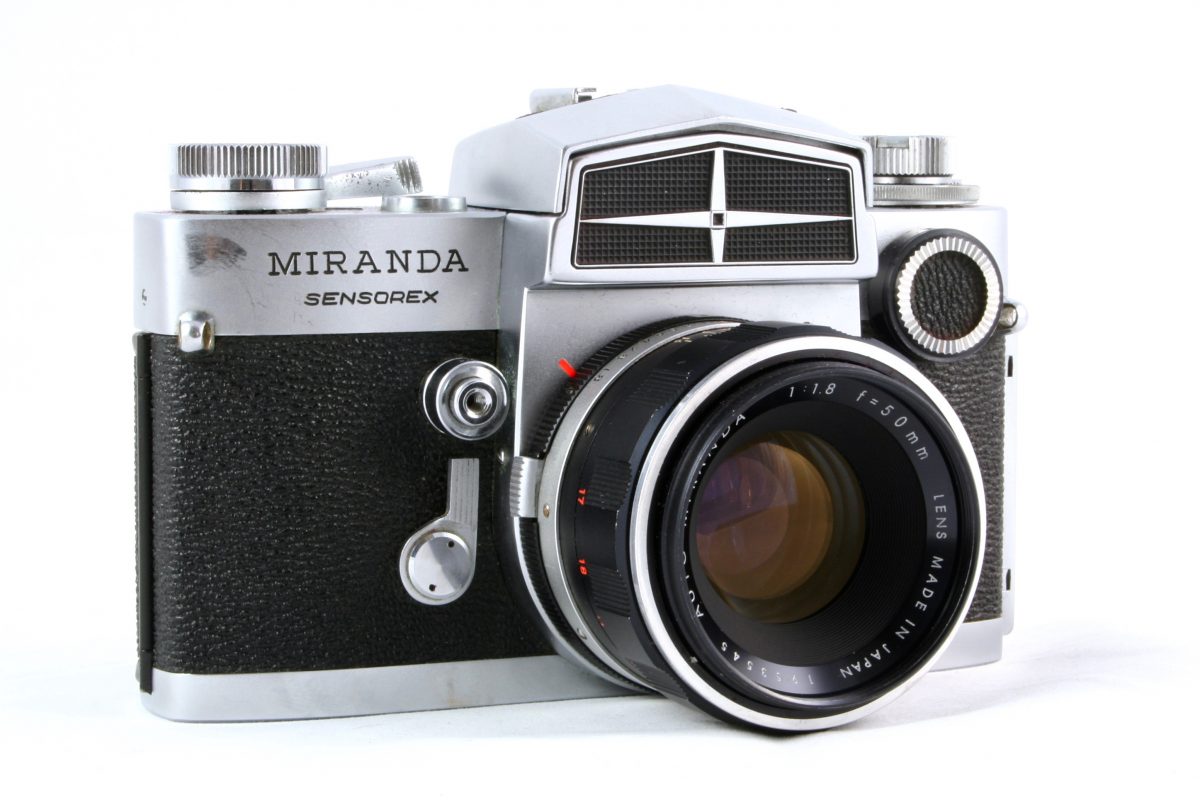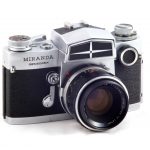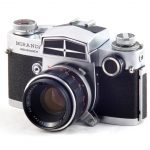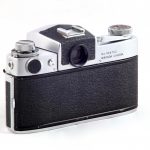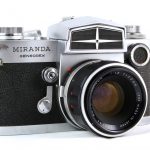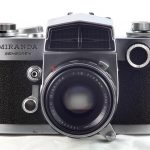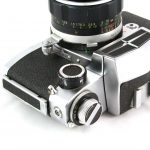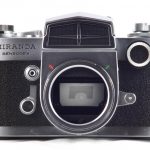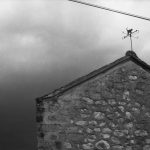Most discoveries happen more by means of luck than because of intuition. We also sometimes owe them to some will to wander out of established trails. It was in Samois-sur-Seine, a nearby village, that I pushed the walk a couple of streets further than the usual annual car boot sale, arms full of Django Reinhard vinyl records, up to a discreet porch where a humble man was managing his isolated stand.
Other than a funny Coronet Twelve whose rounded shape would enlighten the day of many a camera collector, I sensed that the cardboard box was still a bit too much taped to the floor and might contain more. It did indeed contain a SLR case, nicely crafted by the way, with its accessory pouch. I unclipped the case button and… Lucky draw!
The striking detail: a massive chromed four pointed star
I already had the chance to meet this particular camera in antique 60s magazines. No chance to miss it, because the Japanese designers of the Miranda Camera Company added the detail that makes their camera memorable: a massive four-pointed star decorates the camera prism. Difficult not to compare it to some vintage car radiator grill. Let me introduce the Miranda Sensorex.
Introduction
Built by the Miranda Camera Co. starting in 1967, the Sensorex is a really heavy 35mm SLR camera with interchangeable lens system. Its weight seems today inconceivable: 758g… body only! With the standard lens, it is rather 978g! The camera offers a good grip with lots of surface to lay your finger and firmly sustain the body weight. Nevertheless, beware of stiff muscles when you bring it, and its kilogram, on a full day walk.
The top cover is strangely simple. It is missing something. You can find the speed selection wheel. They go from 1 to 1/1000th of a second, pretty efficient in its time. It also provides a film sensibility selector, from 25 to 1600 ASA. Below the wheel, the film advance lever lets you cock the cloth shutter and get to the next frame in a quite short stroke. Other than these, you can find a cocking indicator, and the frame counter.
So, where is the shutter release? It is cunningly placed on the front, next to the lens, right above the self-timer lever, just like Zeiss Ikon/Pentacon was already doing on its Contax range. You use you middle finger to release the shutter while both your thumb and index finger firmly grip the top cover. This handling is natural and efficient.
Where is the shutter release? It is cunningly placed on the front. This handling is natural and efficient.
Left hand side is more crowded. The simple rewind lever tops the internal cell switch. The battery compartment is located on the rear of the cover, easily accessible above the back door. The battery used is a PX625 mercury, which you can replace with alkaline. I only shot black and white in this camera so pay attention to exposure errors with more sensible emulsions.
Still to the left, on the front, a manual selector lets you choose the widest aperture of the mounted lens, from f/1.4 to f/8. It then neutralises widest aperture in the TTL exposure measurements. Luxury, because this functionality only appeared 4 years earlier. Still better, the exposure is weighted from the lower part of the image, as per the markings on the mirror.
Sturdiness and quality
I have heard some concerns about the reliability of the Miranda cameras, and the quality of their optics. Forget these concerns, for they do not apply to the Sensorex.
The overall assembly shows production mastery. The buttons and levers do not suffer from any slack. Each manipulation sometimes needs one to apply a bit of force, but always stays formidably precise. The felted seals survived 50 years of storage and the camera does not let any interfering light in.
I have heard some concerns about the reliability of the Miranda cameras. Forget these concerns.
This set of observations and its massive look make this camera transpire sturdiness and precision. Only the lens that went with my specimen had spread a bit of grease on one optic. Not a problem since the lens is very well made, easy to dismantle, clean, reassemble and adjust.
In summary, the Sensorex had in its time all the equipments of manual SLR cameras that will still exist decades later. As an analogy, the Praktica MTL3 will be born 10 years later with the same range of functionality, only a couple of hundred grams lighter.
However, the Miranda Sensorex isn’t only a very good SLR for its time. It still had some tricks up its sleeve. What are its specifics that make it a unique object?
Ingenuity
The Japanese engineers of the Miranda Co. did not only create a very good SLR, they created a comprehensive modular system.
Starting with the interchangeable prism. A simple push-button loosens the whole top block that slides to the rear. Below the starred face there is only the ground glass left, with its multi-microprism focusing surface.
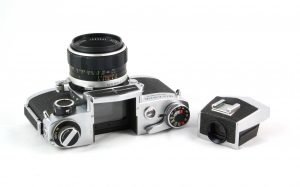
The standard prism enables eye-level focusing. Very bright, it only provides information about the exposure. With the Miranda Auto 50mm f/1.8 lens, the magnification factor of 0.92 lets you compose with both eyes open if you wish. But there exist situations in which an alternative viewfinder system may be of help. So Miranda also offered two other optional prisms.
With the standard lens, the magnification factor of 0.92 lets you compose with both eyes open.
The first optional prism is a waist-level viewfinder, still commonplace when the camera appeared. Waist-level focusing is useful when it is difficult or impossible to get the eye at camera level. It also enables sometimes more discreet shooting situations.
The second optional prism offered two magnification levels: the image center could be magnified 15 times to obtain critical focus. Alternatively, the whole picture could be magnified 5 times. This prism proved very useful especially for macrophotography or microphotography (attached to a microscope).
More surprising is the lens mount. On the Sensorex, it is double! The outside mount is a specific Miranda bayonet. On the inside, the mount contains a 44mm thread. Its purpose was to enable backwards compatibility with the older Miranda lens, a clever idea to create customer loyalty.
The Miranda mount: a twice clever idea!
But the most astonishing is yet to come. The camera has been very carefully designed, the distance between the mount and the film plane has been reduced to the minimum, the widest mount diameter has been chosen. All of this in order to be technically able to provide the widest range of adapters for all kind of lenses from the 60s: M42 (42mm threaded mount like the Tair-11A), Exakta, Topcon, Leica, Canon, Contax, Nikon lenses! Using the corresponding Miranda adapter (the user manual lists seven of them), ability to focus to infinity is preserved without any additional optic. It’s like living a dream!
In the field
So the Sensorex is beautiful, although a bit heavy, it is well equipped and full of promises when it comes to adaptability. But does it perform in the field? Here it is mounted with the standard Auto Miranda 50mm f/1.8 lens. How does it perform?
Great. Although you can see a bit of vignetting to large apertures, the Miranda lens is very sharp even in the angles, as soon as it is closed below f/2.0. Largest apertures provide with a very soft bokeh that tends to whirl a bit (like in the waiter picture).
I went for a walk with the camera loaded with an Ilford FP4 roll, I earned a proper shoulder massage and those wonderful results.
Do not hesitate to ask in the comments if you have questions about the Miranda Sensorex, and please share your pictures shot using this camera with me on Instagram. Have fun !
More info
- As always, the Sensorex on collection-appareils.fr
- A history of the Miranda brand on Benoît Suaudeau’s website (in french).
- Another source in english is available (but older and maybe obsolete) on the Miranda Historical Society website.
- The Miranda Sensorex in my personal collection.
